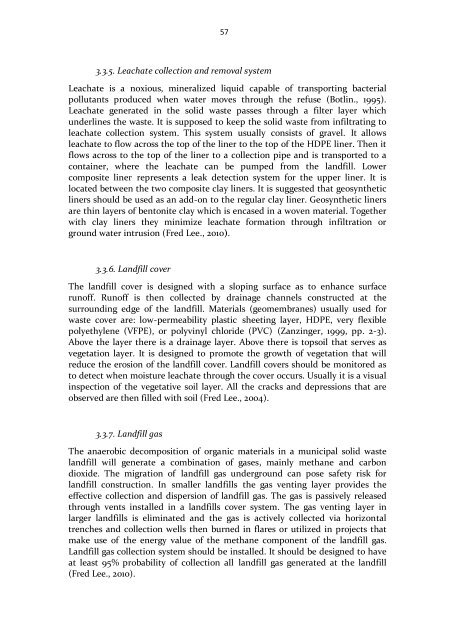(best examples and good practices) on household organic waste ...
(best examples and good practices) on household organic waste ...
(best examples and good practices) on household organic waste ...
Create successful ePaper yourself
Turn your PDF publications into a flip-book with our unique Google optimized e-Paper software.
57<br />
3.3.5. Leachate collecti<strong>on</strong> <str<strong>on</strong>g>and</str<strong>on</strong>g> removal system<br />
Leachate is a noxious, mineralized liquid capable of transporting bacterial<br />
pollutants produced when water moves through the refuse (Botlin., 1995).<br />
Leachate generated in the solid <strong>waste</strong> passes through a filter layer which<br />
underlines the <strong>waste</strong>. It is supposed to keep the solid <strong>waste</strong> from infiltrating to<br />
leachate collecti<strong>on</strong> system. This system usually c<strong>on</strong>sists of gravel. It allows<br />
leachate to flow across the top of the liner to the top of the HDPE liner. Then it<br />
flows across to the top of the liner to a collecti<strong>on</strong> pipe <str<strong>on</strong>g>and</str<strong>on</strong>g> is transported to a<br />
c<strong>on</strong>tainer, where the leachate can be pumped from the l<str<strong>on</strong>g>and</str<strong>on</strong>g>fill. Lower<br />
composite liner represents a leak detecti<strong>on</strong> system for the upper liner. It is<br />
located between the two composite clay liners. It is suggested that geosynthetic<br />
liners should be used as an add-<strong>on</strong> to the regular clay liner. Geosynthetic liners<br />
are thin layers of bent<strong>on</strong>ite clay which is encased in a woven material. Together<br />
with clay liners they minimize leachate formati<strong>on</strong> through infiltrati<strong>on</strong> or<br />
ground water intrusi<strong>on</strong> (Fred Lee., 2010).<br />
3.3.6. L<str<strong>on</strong>g>and</str<strong>on</strong>g>fill cover<br />
The l<str<strong>on</strong>g>and</str<strong>on</strong>g>fill cover is designed with a sloping surface as to enhance surface<br />
runoff. Runoff is then collected by drainage channels c<strong>on</strong>structed at the<br />
surrounding edge of the l<str<strong>on</strong>g>and</str<strong>on</strong>g>fill. Materials (geomembranes) usually used for<br />
<strong>waste</strong> cover are: low-permeability plastic sheeting layer, HDPE, very flexible<br />
polyethylene (VFPE), or polyvinyl chloride (PVC) (Zanzinger, 1999, pp. 2-3).<br />
Above the layer there is a drainage layer. Above there is topsoil that serves as<br />
vegetati<strong>on</strong> layer. It is designed to promote the growth of vegetati<strong>on</strong> that will<br />
reduce the erosi<strong>on</strong> of the l<str<strong>on</strong>g>and</str<strong>on</strong>g>fill cover. L<str<strong>on</strong>g>and</str<strong>on</strong>g>fill covers should be m<strong>on</strong>itored as<br />
to detect when moisture leachate through the cover occurs. Usually it is a visual<br />
inspecti<strong>on</strong> of the vegetative soil layer. All the cracks <str<strong>on</strong>g>and</str<strong>on</strong>g> depressi<strong>on</strong>s that are<br />
observed are then filled with soil (Fred Lee., 2004).<br />
3.3.7. L<str<strong>on</strong>g>and</str<strong>on</strong>g>fill gas<br />
The anaerobic decompositi<strong>on</strong> of <strong>organic</strong> materials in a municipal solid <strong>waste</strong><br />
l<str<strong>on</strong>g>and</str<strong>on</strong>g>fill will generate a combinati<strong>on</strong> of gases, mainly methane <str<strong>on</strong>g>and</str<strong>on</strong>g> carb<strong>on</strong><br />
dioxide. The migrati<strong>on</strong> of l<str<strong>on</strong>g>and</str<strong>on</strong>g>fill gas underground can pose safety risk for<br />
l<str<strong>on</strong>g>and</str<strong>on</strong>g>fill c<strong>on</strong>structi<strong>on</strong>. In smaller l<str<strong>on</strong>g>and</str<strong>on</strong>g>fills the gas venting layer provides the<br />
effective collecti<strong>on</strong> <str<strong>on</strong>g>and</str<strong>on</strong>g> dispersi<strong>on</strong> of l<str<strong>on</strong>g>and</str<strong>on</strong>g>fill gas. The gas is passively released<br />
through vents installed in a l<str<strong>on</strong>g>and</str<strong>on</strong>g>fills cover system. The gas venting layer in<br />
larger l<str<strong>on</strong>g>and</str<strong>on</strong>g>fills is eliminated <str<strong>on</strong>g>and</str<strong>on</strong>g> the gas is actively collected via horiz<strong>on</strong>tal<br />
trenches <str<strong>on</strong>g>and</str<strong>on</strong>g> collecti<strong>on</strong> wells then burned in flares or utilized in projects that<br />
make use of the energy value of the methane comp<strong>on</strong>ent of the l<str<strong>on</strong>g>and</str<strong>on</strong>g>fill gas.<br />
L<str<strong>on</strong>g>and</str<strong>on</strong>g>fill gas collecti<strong>on</strong> system should be installed. It should be designed to have<br />
at least 95% probability of collecti<strong>on</strong> all l<str<strong>on</strong>g>and</str<strong>on</strong>g>fill gas generated at the l<str<strong>on</strong>g>and</str<strong>on</strong>g>fill<br />
(Fred Lee., 2010).










